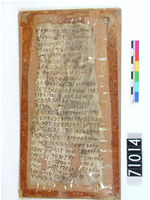| Homepage | Timeline | Maps | A-Z index | Learning |
Parchment (vellum)
Writing material made from animal skins.
Leather rolls as writing ground are already attested in the Middle Kingdom (about 2025-1700 BC), but generally these had not been treated as fully as parchment: however, a fine vellum roll of the 18th Dynasty is preserved in the British Museum (Glanville 1927).
Parchment was specially prepared by tanning, washing, soaking and smoothing the animal skin (most of sheep or goat). The prepared skin was then dressed with alum and treated with sifted chalk. The name parchment derives from Latin Pergamentum. The first century BC Roman writer Varro tells the story that Ptolemy II was in war with the Hellenistic kingdom of Pergamon and prohibited the export of papyrus which was needed for a good working administration. In response to this, the people of Pergamon developed parchment as new writing material. It is not known whether this story is true, and it may be noted that the word Pergamentum appears quite late in written sources. Its first mention is in the price edict of emperor Diocletian (284-305 ) and it might be argued that under his reign there was an important state factory for parchment at Pergamon, which gave the name to the material.
Fragment of a Biblical text (in Coptic)
written on parchment.
(click on the image for a larger picture)
